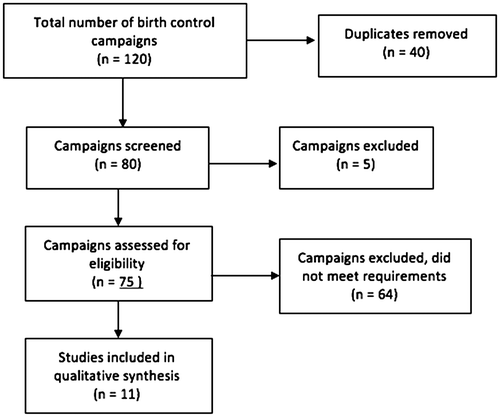Abstract
Objectives: To describe the common features of birth control campaigns for youths and young adults, designed by public and private organizations. Methods: Our team conducted a scan for birth control campaigns, through both online resources and bulletin boards. We limited our search to English language birth control campaigns only, those that were released between January 2014 to March 2016, and campaigns that are targeted towards youths. Results: After applying all the limitations, we were left with 11 campaigns. We summarized the content and the communication mode of the campaigns into 4 broad categories: government, non-government, private, and school boards. Birth control campaigns are generally informative and designed to attract the attention of a specific target population. In general, most campaigns are tailored in a culturally appropriate manner to increase community members’ receptiveness towards this topic. Conclusion: Birth control campaigns have been used to disseminate birth control options to youths and young adults. The interactive and personalized campaign quotes were mainly used to help attract target audiences and spread public health messages about the use birth control measures. Future birth control campaigners should consider using these features to help them design and deliver their campaigns.
Keywords:
Public Interest Statement
Public health campaigns, such as posters, banners and online websites, have been used as a form of medium to communicate health related information to the public. The topic on birth control has been a public health concern as sexual health and unwanted pregnancies are considered part of women’s health. As such, most government public health agencies have developed birth control campaigns to raise awareness about safe sex, and the different types of contraception available within the community. However, birth control campaigns have drawn the attention of other organizations such as non-government organizations, private companies, and school boards. These organizations have taken an active role in promoting birth control campaigns to different target audiences – youths, or community leaders. It is important that birth control campaigns not only target sexually active individuals, but also community leaders who can influence or implement culturally relevant birth control measures within their local community members.
Competing Interests
The authors declare no competing interest.
1. Introduction
Public health campaigns are a vital mode of communication to promote awareness on specific health issues to their respective communities. The style and delivery of these campaigns have progressed in the past decades, from traditional campaign posters and slogans to interactive online campaigns (Shi, Citation2014). Some campaigns, such as birth control campaigns, incorporate personalized messages to promote behavioral change, while others adopt a community approach to mobilize public action for policy change (Coffman, Citation2002). While researchers often evaluate the effectiveness of public health campaigns, there is limited research that summarizes the common features of birth control campaigns designed by public and private organizations.
Over the last ten years, the number and variety of public health birth control campaigns have been steadily rising (Davis, Citation1982). The topic on birth control was once considered taboo. However, with increased awareness and promotion of birth control measures, there has been a wider acceptance on the use of contraception in today’s society. With the help of the media, this topic is now more openly discussed among the younger generation than in the past (Bleakley, Citation2006). Unplanned pregnancies are a growing concern, and is perceived as a major public health issue; thus, governmental and non-governmental organizations are actively promoting birth control campaigns to address this concern (Shi, Citation2014). Planned Parenthood (Citation2016) has found a 5% increase in the number of unplanned pregnancies in North America. According to Sweat, Denison, Kennedy, Tedrow, and O’Reilly (Citation2012), an unplanned pregnancy can worsen a mother’s social determinants of health and lead to detrimental outcomes such as abortion. Thus, it is necessary to raise the public’s awareness on this issue. Bleakley (Citation2006) reported 1.3 million unplanned pregnancies in the United States and this number increases annually. These statistics demonstrate a public health concern, and different organizations have taken active roles in promoting birth control measures. While there are numerous birth control campaigns, and review articles that evaluate the effectiveness of birth control campaigns, there are no articles that summarize the common features of birth control campaigns among varying organizations such as government, private, and non-governmental organizations. This paper aims to describe and summarize the common features of birth control campaigns from each organization.
2. Methods
Our team conducted a global search (i.e. from developing and developed countries) for birth control campaigns from various organizations such as Public Health Units in Canada, pharmaceutical companies, school boards and non-governmental organizations. We also extended our search to online websites e.g. Facebook, Twitter, and online blogs, mobile applications e.g. Snapchat, and Whatsapp, and information exchange sites e.g. government IT sites and Public Health Unit chat sites. Other than online campaigns, our team also looked for birth control posters posted on bulletin boards around London, Ontario. As English language was the common language among all team members, we decided to include only English campaigns. We selected birth control campaigns from January 2014 to March 2016 due to the team’s availability to search beyond this time frame. Our team also choose to only select campaigns that targeted youths and young adults as they are likely to use birth control products. The team is made up of five graduate students from a Masters of Public Health program, and a faculty advisor at the university. Each graduate student obtained various undergraduate degree such as medicine, nursing, life sciences, psychology and Chinese medicine, while the faculty advisor is a teaching professor at the Public Health faculty in the university. Due to time constraint, each team member searched for 20 campaigns.
After we conducted our first round of research, our team gathered a total of 120 campaigns. After removing the duplicate campaigns, we were left with 80 campaigns. We then reviewed the 80 campaigns to ensure that the campaigns were within the agreed search dates. Our team identified 5 irrelevant campaigns. We discarded those 5 campaigns, leaving us with 75 campaigns. After screening through the 75 campaigns, only 11 birth control campaigns were identified to be within the set limits i.e. within study period, target population is youth and young adults, and birth control campaigns in English language only (see Figure ). These 11 campaigns were then summarized and broadly categorized into Government, Non-government, Private, and School organizations. By categorizing into these groups, it would capture the patterns and intentions of each organization when developing and planning for birth control campaigns.
3. Results
We have summarized and organized all the 11 campaigns into a table (see Table ).
Table 1. Summary of birth control campaigns
3.1. Government organizations
3.1.1. Campaign #1
“The Clinic” is a poster birth control campaign that is designed by Middlesex-London Health Unit, a public health unit in London, Ontario, Canada. This campaign is a simple poster design that lists out the different birth control services that are available at the local public health unit. It also displays the public health unit’s address for people who are interested in seeking the service. The poster ends off with a quote “Know Your Choices”. This poster is distributed throughout bulletin boards around London to communicate birth control options to local community members (Refer to Figure ). This poster is also available on Middlesex-London Health Unit website under the Sexual Health Clinic section.
Figure 2. “The Clinic” poster by Middlesex-London Health Unit. This campaign is a simple poster design that lists out the different birth control services that are available at the local public health unit.

3.1.2. Campaign #2
The campaign website Sexuality and U provides resourceful information on the various birth control measures available in Canada. The campaign website is easy to navigate as it has clear subheadings. The various sites within the campaign website are user friendly as they provide links to support services for youths. The campaign provides informative diagrams, which provides a visual example for youths who are unfamiliar with contraceptive methods. The images on the campaign’s website were vibrant, and showed youthful individuals smiling into the camera (Refer to Figure ).
Figure 3. “SEX&U”. The campaign website provides resourceful information on the various birth control measures available in Canada.

3.2. Non-government organizations
3.2.1. Campaign #3
The “National Condom Week Indonesia” campaign is a birth control campaign designed by the local authorities. The poster has the campaign name written on the right side of the poster and a stack of condom rims on the left. The poster was designed in red and white. It is more intuitive with no other slogans other than the campaign’s name. It was a plain and simple campaign poster with no other forms of information or graphics on it (Refer to Figure ).
Figure 4. “National Condon Week Indonesia” birth control campaign. Poster is disseminated throughout Jakarta and Jogjakarta to raise awareness on birth control measure.
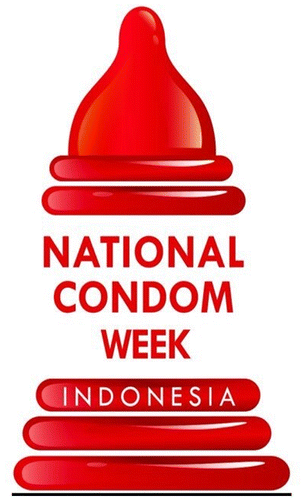
3.2.2. Campaign #4
“Woman Deliver” is a campaign that advocates for the rights of women in developing countries. It also specifically targets birth control issues in youths living in developing countries. The campaign site is mainly green in color and has a variety of information ranging from resources availabilities to support women and young girls in birth control planning, to stories of these women. There are many captivating images of these women with powerful quotations such as “Never underestimate the power of a woman” (Refer to Figure ).
Figure 5. “Woman Deliver” campaign website that has many interactive links to relevant resources about birth control.
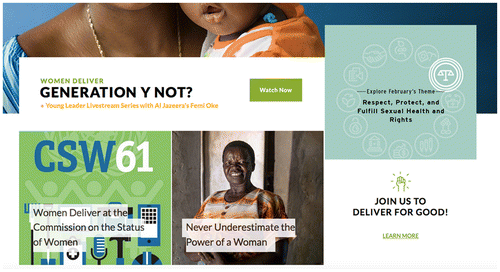
3.3. Private organizations
3.3.1. Campaign #5
This campaign is designed by Bedsider.org that displays “Doing the 9 to 5 thing for my career before I do the 24-7 thing for a baby”. This campaign is designed with a yellow background and has artistic and attractive fonts. This campaign was posted both online and was printed as a wallet card. Bedsider.org also developed this campaign into a mini-clip animation to educate the youths on their priorities (Refer to Figure ).
Figure 6. “Thanks birth control” poster campaign designed by The National Campaign to Prevent Teen and Unplanned Pregnancy with catchy colors and designs.

3.3.2. Campaign #6
The second campaign message is “Let’s (not) make a baby”. This campaign was developed with a comical theme and ends with a girl winking her eye. This cartoon diagram and artistic writings are attractive, eye catching and more acceptable by youths. The campaign content was disseminated both online and on wallet-sized cards (Refer to Figure ).
Figure 7. “Thanks birth control” poster campaign designed by The National Campaign to Prevent Teen and Unplanned Pregnancy with catchy colors and designs that can be seen online and on posters.
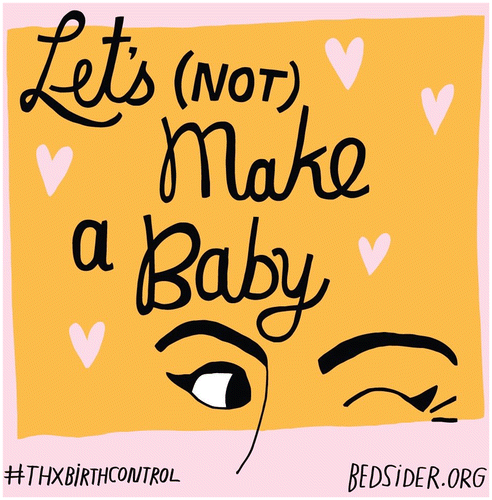
3.3.3. Campaign #7
The third campaign is designed in a colorful manner that states “Working Hard, Living the Dream”. The fonts were catchy, displayed in bolded and bright colors. The emphasis on “living the dream” was bolded in red, and stands out from the light blue background (Refer to Figure ). This poster was disseminated both online and as a poster.
Figure 8. “Thanks birth control” poster campaign designed by The National Campaign to Prevent Teen and Unplanned Pregnancy with catchy colors and designs that can be seen online and on posters.

3.3.4. Campaign #8
The Allergen online campaign is interactive as it introduces different birth control methods using both cartooned diagrams and media. The campaign’s website is colorfully decorated with artistic fonts and creative pictures (Refer to Figure ). It includes short video clips that introduce the different birth control measures and their effectiveness. It also has a list of relevant links for users to refer to. The overall website is colorful and has social media links such as Instagram, Facebook and twitter for users to follow and learn about the latest updates of birth control measures.
Figure 9. “#ActuallySheCan” online birth control campaign by a pharmaceutical company, Allergen. A user-friendly website that allows easy navigation.
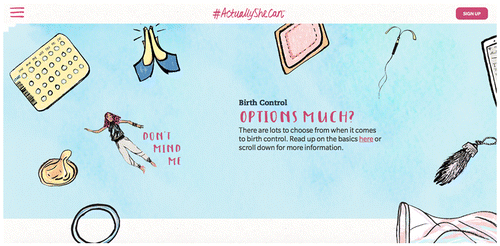
3.4. School organizations/boards
3.4.1. Campaign #9
This campaign had hand drawn pictures of families and children. The campaign is titled “Healthy Children, Happy Parents, Stable Families” (Refer to Figure ). This campaign message was simple and direct. The cartoons on the background were brightly colored to draw the attention of youths. This campaign was also made into a mini-clip and a wallet card.
Figure 10. “Thanks birth control” poster campaign designed by The National Campaign to Prevent Teen and Unplanned Pregnancy with cartoon diagrams and catchy colors.
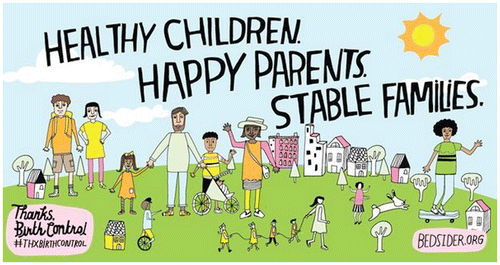
3.4.2. Campaign #10
This campaign is designed by Bedsider.org and has a catchy and meaningful quotation that reads “love my nieces and nephews. Also love going home after chasing them for 8 h” (Refer to Figure ). This quotation is written in a cartoon font, which appears comical and eye-catching. The diagram used in this campaign showed adults chasing kids, surrounded by hearts. This campaign comes in the form of mini card handouts (The National Campaign, Citation2014).
Figure 11. “Thanks birth control” poster campaign designed by The National Campaign to Prevent Teen and Unplanned Pregnancy with comical diagrams and slogans.
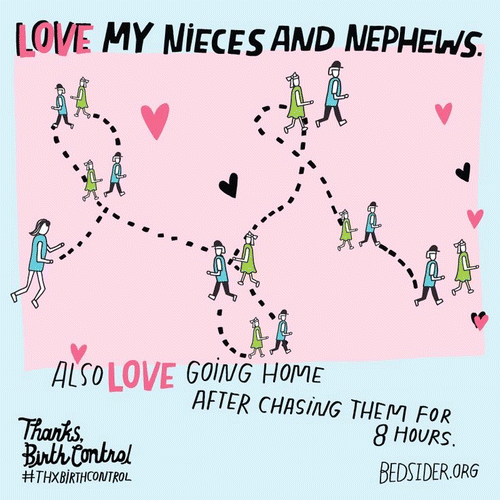
3.4.3. Campaign #11
A campaign by the National Campaign to Prevent Teen and Unplanned Pregnancy organization is colorful and comical. The campaign slogan states “Back off baby, I’m in school” (Refer to Figure ). It shows an image of cartoon sperms moving towards a pink dot, which represents a female’s ovum. The ovum is being cartooned with a “skeptical” look and staring at the sperm. In addition, the pink dot is wearing motar board which signifies educational achievement.
Figure 12. Birth control poster campaign designed by The National Campaign to Prevent Teen and Unplanned Pregnancy with comical diagrams and slogans.
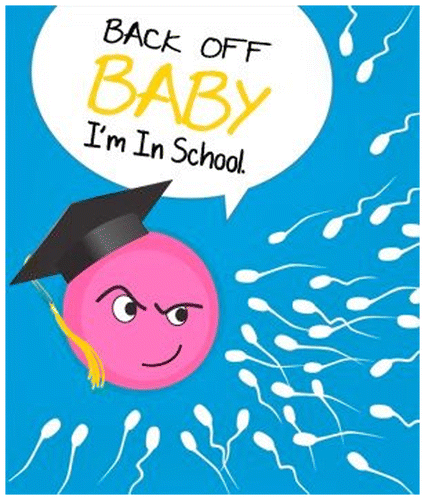
4. Discussion
4.1. Government organizations
As seen from the descriptions of campaigns 1 and 2, the role of governmental organization is to provide evidence-based information to the public to make an informed decision. Most governmental birth control campaigns, ads, and information take a non-controversial stance. Both national (Public Health Agency of Canada [PHAC]) and local public health units use websites and fact sheets to communicate and deliver information about different birth control methods, benefits and risk factors of each birth control method, and where to obtain further information and access to the such birth control methods.
PHAC uses an external website called Sexuality and U, from The Society of Obstetricians and Gynecologists of Canada, for their sexual health communication regarding birth control. This website conveys the message that sex is natural but pregnancy should happen when that individual is ready for a pregnancy. The Sexuality and U campaign website stresses the importance of choosing a type of birth control that is right for the person and their partner. Contraception information on the Sexuality and U website ranges from natural family planning methods to non-hormonal and hormonal birth control methods (Sexuality & U, Citation2016). By taking this approach, PHAC sets an exemplary framework for provincial and municipal health units to design, develop and disseminate the appropriate type of content to the public and specifically to the target population.
While PHAC sets out the national guidelines on birth control measures, provincial health services have adopted these guidelines to be used in their respective province. These provincial guidelines are further adopted and disseminated by local health units, to ensure that standard practices are being delivered within each community. Local health units are an extension of the national government organizations, resulting in a consistent content delivery on birth control information. As such, local health units develop campaigns that tie in similar messages as PHAC, such as creating awareness on the different types of birth control methods. The message mainly relays the facts and risks of each birth control method to the public and to the specific target population.
Middlesex London Health Unit (MLHU) is a local health unit that oversees public health issues in Middlesex Region in Ontario, and delivers the birth control campaign entitled “The Clinic” (2013). This campaign listed the different functions MLHU has, including birth control. The caption at the bottom of this campaign in big letters is “Know Your Choices” with the word “choices” being very prominent. Although this might be an effective mode of communication for government or public organizations, as they want to appeal to the largest population possible, Bleakley (Citation2006) found that posters and websites target 62% of young adults, but could only capture 23% of the youth community. In comparison, Toronto Public Health uses Facebook to promote birth control campaigns. Through this platform, approximately 59% of the views come from the youth communities (Andrew-Gee, Citation2015). Though local health units are required to follow certain mandates set by PHAC and their provincial health service, they have the autonomy to tailor communication styles and themes according to the community’s culture and habits (PHAC, Citation2016). Providing local health units with autonomy enables local public health units to be directly involved in campaign communications (Moloughney, Citation2007). This provides a sense of community well-being and cohesiveness for both public health units and the general public.
Having an un-biased and impartial approach is beneficial, because this enables government health units to provide important information to the public without pushing an ulterior agenda. This helps community members develop trust towards health information, so they are able to approach local health units for advice (Osborne, Radnor, & Nasi, Citation2013). This helps develop a close-knit relationship between the public health unit and the community. The public will also be more receptive to this type of information, which can foster trust about the reliability of the information (Osborne et al., Citation2013).
Since government organizations’ target individuals of reproductive age, having online resources has become appropriate because of its convenience and easy accessibility. Hesse et al. (Citation2005) reported that more individuals accessed information online before talking to their physicians. This could contribute to an open communication with their healthcare provider when it comes to mitigating factors such as stigmas around sexual health and family planning (Graham & Brookey, Citation2008). Given the shift in how community members receive and search for birth control information, certain government health units have taken on a proactive approach by using various multimedia platforms to engage their community in creating birth control awareness campaigns (Shi, Citation2014).
4.2. Non-government organizations (NGOs)
NGOs are unique organizations because they represent “the voice of the people”. According to World Bank (Citation1996), NGOs conduct activities to relieve suffering, promote the interests of the poor, protect the environment, provide basic social services, and undertake community development. Public surveys indicate that NGOs often enjoy a high degree of public trust, which makes these organizations useful in delivering public health content (International Institute for Sustainable Development, Citation2013). NGOs generally adopt diverse strategies when delivering birth control campaigns in different countries. For instance, the United Nations Population Fund (UNFPA) organization promotes birth control by linking birth control with reproductive health, rather than preventing unplanned pregnancies. Furthermore, due to limited funding and human resources, NGOs often collaborate with local leaders to help promote birth control campaigns in a culturally appropriate manner to the target population (Hann, Citation2005).
Interestingly, some NGO campaigns focus on educating and providing awareness to religious authorities, employers, and other community leaders rather than the target user population. In 2012, Indonesia’s National Family Planning Coordinating Board collaborated with various NGOs in promoting birth control awareness throughout Jogjakarta and Jakarta (Putjuk, Citation2014). These campaigns mainly focused on engaging and empowering community leaders with culturally-sensitive birth control knowledge and options. With this knowledge, local leaders can make sense of this information and decide how to disseminate appropriate information to their local community. By engaging with local leaders and empowering them with knowledge, NGOs have gained the trust of community leaders. They provide guidance to help them create and disseminate appropriate birth control measures and options (Sweat et al., Citation2012).
Several NGOs have used peer education as a method of disseminating birth control information to local communities. One such example is the Family Care International (FCI) organization which conducted a campaign that aimed to reduce teenage pregnancy in Mali, where most of the population is under 25 and over 40% are females between 15 and 19 years old (FCI, Citation2011). FCI developed a peer-to-peer education program by training 15 females and 15 males about sexual and reproductive health knowledge (FCI, Citation2011). These trained participants then conveyed family planning information, distributed condoms, and created awareness posters to their community members. This trained peer educator initiative led to a successful knowledge exchange regarding birth control (FCI, Citation2011). Jalalina, Therani, Malekafzali, and Peykari (Citation2013) reported that a peer educator initiative can be more effective when training programs have well defined knowledge to be disseminated to peer educators, and program planners have a good idea on peer educators’ communication skills and behavior. Another birth control campaign that uses peer educators to share knowledge on teenage pregnancy and birth control options in developing countries is the “Women Deliver” campaign. The campaign helped disseminate the issues of teenage pregnancy to young girls in local schools. The results showed that young school girls could articulate the problems of teenage pregnancy after the in-class peer education session (Women Deliver, Citation2014). Although these two campaigns use the peer educator initiative, such approach would only be successful with the support of local community leaders and partnership (Hann, Citation2005).
A possible limitation that NGOs generally face is the use of new communication in developing countries. The availability of data and internet is limited in developing countries like Mali, which will affect how NGOs decide on the different feasible methods of transmitting birth control knowledge to the local communities (Strasser, Citation2003). Like the FCI organization, NGOs in developing countries focus on interpersonal communication about contraception information through posters, printed photos, curriculum workbooks, and slides for peer educators (Strasser, Citation2003). The use of the interpersonal communication method is directed at community members to help raise awareness and promote message sustainability (Freimuth & Quinn, Citation2004).
While birth control campaigns designed by NGOs and local leaders are culturally sensitive, they often take a more personalized approach when delivering messages (Strasser, Citation2003). To shape behavioral change, towards taboo topics like birth control, most campaigns that NGOs deliver, involve rallying local support and talking to community members (Sweat et al., Citation2012). This approach helps maximize the success of the birth control campaign, and improves social wellbeing (Coffman, Citation2002).
4.3. Private organizations
Private organizations, since the late 1990s, have played a major role in birth control campaigns (Avery et al., Citation2010). There are two main types of private organizations in North America that play an active role in birth control campaigns.
The first type is non-profit independent organizations that are largely unbiased. The approach used is based on the assumption that contraception is a controversial and taboo topic in society, politics, and media. “The National Campaign to Prevent Teen and Unplanned Pregnancy”, a non-profit Washington D.C. private organization, utilizes a variety of communication mediums to educate the public about the availability of different types of birth control in North America. In partnership with Bedside.org, “The National Campaign to Prevent Teen and Unplanned Pregnancy” aims to normalize conversations about birth control in society. This led to the launch of the “Thanks, Birth Control” campaign, which provided an open platform for people to thank what birth control allowed them to do (Storm, Citation2013). Although “The National Campaign to Prevent Teen and Unplanned Pregnancy” has altruistic intentions to improve the lives of children and families by preventing teen and unplanned pregnancy through supportive campaigns, the organization is likely trying to establish itself as a leading research and campaign organization in this field (The National Campaign, Citation2017). These campaigns would attract top researchers or health professionals to be part of the organization’s advisory committee (The National Campaign, Citation2017). With influential people guiding the organization’s committee, this could potentially attract more funding opportunities for future campaigns or research. This would also increase the organization’s credibility, and potentially influence politicians to increase investment in this field.
The second type of private organization is for-profit organizations, such as pharmaceutical companies that manufacture birth control products. These organizations generally create campaigns to market and promote their birth control products for economic reasons. An example would be “Allergan”, a global pharmaceutical company that aims to provide the birth control pill as part of a large repertoire of reproductive health products, to endorse their organization as a women’s healthcare company to the public (Allergen, Citation2017).
In 2015, Allergan launched a marketing campaign on Facebook and Twitter platform to advertise the organization’s birth control pill, which aimed to help educate young women about the birth control pill, and how this pill can be an important asset to their sexual health (Shayon, Citation2015). This campaign featured cartoon images of a hip, purple haired, young woman with birth control pills in her purse. Campaigners realized that using popular culture as a medium to relay knowledge on birth control would not only capture the audience attention, but also most importantly help make such conversation easier among friends and families (Liran et al., Citation2015). Furthermore, the use of social media such as Facebook and Twitter ensure a quick and easy informative message for large populations who tune in to these applications. This is an ideal pact for both public health campaign organizers and social media stakeholders.
Allergan also conducted market surveys and found that using hashtags and emojis to promote birth control pills to millennial women is both engaging and non-offensive. For example, the #ActuallySheCan campaign primarily targets women between the ages of 15 and 35, where discussion on the benefits of birth controls uses hashtags to reiterate the purpose of the campaign and encourage the spread of knowledge. While the social media medium is being used to deliver this campaign to the younger audience, the use of hashtags and “hipster” humor may not appeal to everyone. Kreuter and McClure (Citation2004) reinforces that sensitivity towards local culture should still be the fundamental consideration when designing campaigns, whilst incorporating new cultural trends. This concept serves as a stop-gap measure for campaigners to ensure sensitivity is being considered for campaigns to succeed (Kreuter & McClure, Citation2004).
Private organizations generally have more funds than other organizations to deliver and spread birth control awareness (Cleland et al., Citation2006). Although private organizations generally prioritize profits based on resource availability, they could consider collaborating with pharmacies that are in rural areas to deliver birth control awareness messages. However, the mode of communication should be factored in when planning to reach out to rural and remote areas. As most campaigns use online platforms that require data connection, these communication methods might not effectively reach out to potential rural users who live in areas with limited Internet access (Martinez, Villarroel, Seoane, & del Pozo, Citation2005). Given this limitation, private organizations can consider sponsoring birth control campaign materials such as brochures and interactive reading materials that promote certain birth control pills or products. These private organizations can also potentially develop a long-term collaboration plan with local communities by providing birth control products at a lower cost. This collaboration could help private companies reduce costs in the long run as local pharmaceutical companies gain autonomy in decision-making for birth control measures and distribution (Bustreo, Harding, & Axelsson, Citation2003). Furthermore, when trust and understanding is established between the local community and private organizations, future birth control campaigns could be designed according to local communication practices such as community-based outreach programs, door-to-door promotion or group discussions.
4.4. School organizations/boards
The National Campaign to Prevent Teen and Unplanned Pregnancy organization also actively collaborates with schools to promote birth control awareness. This collaboration between The National Campaign to Prevent Teen and Unplanned Pregnancy organization and school boards targets and supports both secondary and post-secondary schools. Recently, this organization launched an online birth control campaign called “Make it personal: College Completion” (Fain, Citation2013). This campaign used a webinar to promote awareness about contraceptive options for college students. This campaign aimed to increase graduation rates among college students by providing birth control education and offering support service choices (The National Campaign, Citation2016). To attract the attention of college students, colorful backdrops and popular culture images were used. Furthermore, the use of online resources and social media such as YouTube and Twitter draws attention from many university students; as they are frequent users of these social platforms (Wymer, Citation2015). Interactive social media tools used by the campaign include comedic postcards such as “Back off Baby, I’m in school”. Comedic slogans were found to attract the attention of youths, which explains the strategy used by the National Campaign organization (Barker, Citation2009). This campaign’s communication is mainly based on the health belief model - a model that focuses on the attitudes and beliefs of individuals, as it helps students to consider how unplanned pregnancy can affect their educational goals and other aspects of life.
Birth control campaigns that are promoted in schools generally have eye-catching captions, for instance, “Love Your Body Week” (Grinnell College), “Halloween Condom Campaign” (University of Buffalo), and “Condom Couture” (University of Maryland, College Park). These campaigns consist of phrases, which carry “sexual” connotations that draws the attention of curious college students. This strategy helps raise awareness about birth control measures, while students learn about the importance of birth control choices in a “fun” manner (Livingstone, Citation2008).
Birth control campaigns organized by school boards consider the fact that students might not be open towards talking or asking about birth control options (Jones, Biddlecom, Hebert, & Mellor, Citation2011). This creates a major barrier for students who are sexually active and require access to reproductive health support services (Jones et al., Citation2011). Furthermore, their fear of broaching such topics with their parents might cause youths to make harmful choices (Sanoff, Citation2015). As such, birth control campaigns that are held in schools are delivered in appropriate ways, without confrontation through means such as posters, billboards and promotional booths. The use of these options to reach out and communicate birth control messages were found to be effective in raising awareness among youths (Sprecher, Harris, & Meyers, Citation2008). Furthermore, school boards are now extending beyond the traditional ways of campaigning as they consider involving other stakeholders such as mobile companies and external health organizations. Campaign messages could be spread even faster through free text messages and free data use for birth control campaign mobile apps (Jones & Biddlecom, Citation2011). In addition, with Facebook and Twitter, students are more inclined to use these social platforms, to acquire information to self-educate and to acquire knowledge on birth control options (Jones & Biddlecom, Citation2011).
The methods used by school boards and organizations to spread birth control awareness messages were interactive and relevant to hold their target population. Campaign results from the National Campaign to Prevent Teen and Unplanned Pregnancy organization were positive, hence, such communication strategies should be maintained to continuously disseminate pertinent sexual health and birth control messages through suitable media platforms to school-aged youths (The National Campaign, Citation2011). Furthermore, school boards should send out newsletters about the birth control campaigns held in schools. This allows parents to be socially aware of the types of birth control content that teens are receiving, while reassuring these adolescents that their privacy regarding birth control choices is maintained (Jaccard, Dittus, & Gordon, Citation2000). Another approach that school boards and organizations could adopt would be to promote birth control campaigns as in-class sessions (Hunter-Geboy, Citation1995). This enclosed setting would create a comfortable environment for discussions, and encourage students to raise concerns on sensitive issues relating to birth control measures (Talib, Mamat, Ibrahim, & Mohamad, Citation2015). Sanoff (Citation2015) reported that promoting birth control awareness in schools is challenging since campaign messages should be tailored and the use of media must be approved by schools. This serves to remind future campaigners that having the right stakeholders on board early on during the designing of school birth control campaigns is crucial.
5. Recommendations
The 11 campaigns from different organizations have demonstrated some similarities, example the use of personalized statements, or cartoon characters to attract target audiences. The features that our team have described could help future organizations plan and develop birth control campaigns for their target audience. Future research could consider evaluating the effectiveness of birth control campaigns that target youths and young adults. This would provide future campaigners insights to what features or methods are effective in attracting larger audiences. Furthermore, future research could also compare the differences between poster and online birth control campaigns. This would give future campaigners an idea which mode of campaigning would be effective.
6. Conclusion
In summary, birth control has been a rising concern in the realm of public health in recent years. Different organizations have been proactive in taking the initiative to promote birth control measures and create awareness about different choices that are available to sexually active individuals. The interactive and personalized campaign quotes were mainly used to help attract target audiences and spread public health messages about the use birth control measures. Future birth control campaigners should consider using these features to help them design and deliver their campaigns.
Ethics
As this paper does not involve human subjects or direct contact with any participants, our team did not apply for ethics review.
Acknowledgements
Our team would like to thank the Public Health Faculty at Western University, Canada for giving graduate students the opportunity to work as a team and aim for publication.
Additional information
Funding
Notes on contributors
Joanne Tay
This paper was put together by 5 graduate students and 1 faculty advisor from the University of Western Ontario, Masters of Public Health program. Each team member has an interest in health communications, as such, we came together to synthesize what have different organizations done to promote birth control campaigns. The first author, Joanne Tay, is a current PhD student at the University of Toronto. Her main research interest is in public health related issues such as women and child’s health. She identified that birth control options are not always accessible for young girls who are sexually active because of political constrains or funding limitations. The purpose of this paper is therefore to synthesize and provide an overview of what different organizations are doing, and how similar organizations could adopt or adapt similar methods to promote birth control measures in their community.
References
- Adolescents and Young People. (2014). Women deliver. Retrieved April 17, 2016, from https://www.womendeliver.org/knowledge-center/facts-figures/adolescents-and-young-people/
- Allergen. (2017). Corporate governance. Retrieved from https://www.allergan.com/investors/corporate-governance
- Andrew-Gee, E. (2015). Facebook most popular, Instagram most loved in social media survey. Retrieved from https://www.thestar.com/business/2015/01/09/facebook_most_popular_instagram_most_loved_in_social_media_survey.html
- Avery, E., Lariscy, R., Amador, E., Ickowitz, T., Primm, C., & Taylor, A. (2010). Diffusion of social media among public relations practitioners in health departments across various community population sizes. Journal of Public Relations Research, 22, 336–358.10.1080/10627261003614427
- Barker, V. (2009). Older adolescents’ motivations for social network site use: The influence of gender, group identity, and collective self-esteem. CyberPsychology & Behavior, 12, 209–213.10.1089/cpb.2008.0228
- Bleakley, A. (2006). Public opinion on sex education in US schools. Archives of Pediatric and Adolescent Medicine, 160, 1151–1156.10.1001/archpedi.160.11.1151
- Bustreo, F., Harding, A., & Axelsson, H. (2003). Can developing countries achieve adequate improvements in child health outcomes without engaging the private sector? Bull World Health Organization, 81, 886–895.
- Cleland, J., Bernstien, S., Ezeh, A., Faundes, A., Glasier, A., & Innis, J. (2006). Family planning: The unfinished agenda*. The Lancet Sexual and Reproductive Health Series, 368, 1810–1827. doi:10.1016/S0140-6736(06)69480-4
- Coffman, J. (2002). Public communication campaign evaluation: An environmental scan of challenges, criticisms, practice, and opportunities. Harvard Family Research Project. Retrieved September 4, from https://owl.uwo.ca/access/lessonbuilder/item/58059089/group/587e6268-2f83-4bd0-98fb-5a7ccc0e6407/Class%2012,%20Apr.%2012/Public%20Communication%20Campaign%20Evaluation.%20Coffman,%20 J.%202002.pdf
- Davis, A. (1982). Racism, birth control and reproductive rights (pp. 202–271). New York, NY: The Women’s Press. Retrieved April 12, from https://www.law.berkeley.edu/php-programs/centers/crrj/zotero/loadfile.php?entity_key=B2BPACD3
- Fain, P. (2013). Birth control and college completion. Retrieved from https://www.insidehighered.com/news/2012/03/12/campaign-links-pregnancy-planning-graduation-rates-community-colleges
- FCI. (2011). Mali expands sexual health program for young people. Author. Retrieved 15 April 2016, from https://www.familycareintl.org/en/orphan/31
- Freimuth, V. S., & Quinn, S. C. (2004). The contributions of health communication to eliminating health disparities. American Journal of Public Health, 94, 2053–2055.10.2105/AJPH.94.12.2053
- Graham, S., & Brookey, J. (2008). Do patients understand? The Permanente Journal, 12, 67–69.
- Hann, N. E. (2005). Transforming public health through community partnerships. Preventing Chronic Disease, 2, 1–5. Retrieved from www.cdc.gov/pcd/issues/2005/nov/05_0072.htm
- Hesse, B. W., Nelson, D. E., Kreps, G. L., Croyle, R. T., Arora, N. K., Rimer, B. K., & Viswanath, K. (2005). Trust and sources of health information: The impact of the internet and its implications for health care providers: Findings from the first health information national trends survey. Archives of Internal Medicine, 165, 2618–2624. doi:10.1001/archinte.165.22.2618
- Hunter-Geboy, C. (1995). Life planning education: A youth development program. Washington, DC: Advocates for Youths. Retrieved from https://www.advocatesforyouth.org/storage/advfy/documents/lpe.pdf
- International Institute for Sustainable Development. (2013). The rise and role of NGOs in sustainable development. Author. Retrieved April 17, 2016, from https://www.iisd.org/business/ngo/roles.aspx
- Jaccard, J., Dittus, P. J., & Gordon, V. V. (2000). Parent-teen communication about premarital sex: Factors associated with the extent of communication. Journal of Adolescent Research, 15, 187–208.10.1177/0743558400152001
- Jalalina, S. D., Therani, F. R., Malekafzali, H., & Peykari, N. (2013). Peer education: Participatory qualitative educational needs assessment. Iran Journal of Public Health, 42, 1422–1429.
- Jones, R., Biddlecom, A., Hebert, L., & Mellor, R. (2011). Teens reflect on their sources of contraceptive information. Journal of Adolescent Research, 26, 423–446. doi:10.1177/0743558411400908
- Jones, R. K., & Biddlecom, A. E. (2011). Is the internet filling the sexual health information gap for teens? An exploratory study. Journal of Health Communication, 16, 112–123.10.1080/10810730.2010.535112
- Kreuter, M. W., & McClure, S. M. (2004). The role of culture in health communication. Annual Review of Public Health, 25, 439–455.10.1146/annurev.publhealth.25.101802.123000
- Liran, C. S., Pnagiotopoulos, P., Regan, A., De Brun, A., Barnett, J., Wall, P., & McConnon, A. (2015). Interactive communication with the public: Qualitative exploration of the use of social media by food and health organizations. Journal of Nutrition Education and Behavior, 47, 104–107.
- Livingstone, S. (2008). Taking risky opportunities in youthful content creation: Teenagers’ use of social networking sites for intimacy, privacy and self-expression. New Media & Society, 10, 393–411.10.1177/1461444808089415
- Martinez, A., Villarroel, V., Seoane, J., & del Pozo, F. (2005). Analysis of information and communication needs in rural primary health care in developing countries. IEEE Transactions on Information Technology in Biomedicine, 9, 66–72. doi:10.1109/TITB.2004.842411
- Moloughney, B. (2007). A discussion paper on public health, local health integration networks, and regional health authorities. Ontario Public Health Association. Retrieved from https://www.opha.on.ca/getmedia/d7eb60bb-063c-421e-b107-f89067966ad0/OPHA-DiscussionPaper-PH-LHINs-Oct07.pdf.aspx?ext=.pdf
- Osborne, S. P., Radnor, Z., & Nasi, G. (2013). A New theory for public service management? Toward a (public) service-dominant approach. The American Review of Public Administration, 43, 135–158.10.1177/0275074012466935
- Planned Parenthood. (2016). Planned Parenthood Federation of America. Annual Report 2015-2016. Retrieved from https://www.plannedparenthood.org/uploads/filer_public/18/40/1840b04b-55d3-4c00-959d-11817023ffc8/20170526_annualreport_p02_singles.pdf
- Public Health Agency of Canada. (2016). Teen pregnancy. Retrieved from https://www.phac-aspc.gc.ca/hp-ps/dca-dea/stages-etapes/ado/pregnancy-grossesse-eng.php
- Putjuk, H. F. (2014). Indonesia’s family planning: From stagnation to revitalization. World Contraception. Retrieved April 17, 2016, from https://www.devex.com/news/indonesia-s-family-planning-program-from-stagnation-to-revitalization-84387
- Sanoff, R. (2015) Seattle public schools are providing free IUDs and other birth control at school-based clinics, thanks to an amazing state program. Retrieved from https://www.bustle.com/articles/87342-seattle-public-schools-are-providing-free-iuds-and-other-birth-control-at-school-based-clinics-thanks-to
- Sexuality and U. (2016). The society of obstetricians and gynecologists of Canada. Retrieved from https://www.sexualityandu.ca/birth-control
- Shayon S. (2015). Will Allergan’s #actuallyshecan campaign help it sell birth control? Retrieved from https://brandchannel.com/2015/07/22/allergan-072215/
- Shi, L. (2014). Micro-blogs, online forums, and the birth-control policy: Social media and the politics of reproduction in China. Culture, Medicine, and Psychiatry, 38, 115–132.10.1007/s11013-013-9351-x
- Sprecher, S., Harris, G., & Meyers, A. (2008). Perceptions of sources of sex education and targets of sex communication: Sociodemographic and cohort effects. Journal of Sex Research, 45, 17–26.10.1080/00224490701629522
- Storm, H. (2013). Today is National “Thanks birth control” day. Retrieved from https://bitchmedia.org/post/what-has-birth-control-allowed-you-to-do-birth-control-day
- Strasser, R. (2003). Rural health around the world: Challenges and solutions. Family Practice, 20, 457–463. doi:10.1093/fampra/cmg422
- Sweat, M. D., Denison, J., Kennedy, C., Tedrow, V., & O’Reilly, K. (2012). Effects of condom social marketing on condom use in developing countries: A systematic review and meta-analysis, 1990-2010. Bull World Health Organ, 90, 612–622A. doi:10.247/BLT.11.094268
- Talib, J., Mamat, M., Ibrahim, M., & Mohamad, Z. (2015). Talking sex in the classroom: What is the right approach? International Academic Research Journal of Social Science, 1, 57–68.
- The National Campagin to Prevent Teen and Unplanned Pregnancy. (2011). National state data: The national story. Retrieved from https://thenationalcampaign.org/data/landing
- The National Campaign to Prevent Teen and Unplanned Pregnancy. (2014). Bedsider campus groups are getting wild about birth control. Retrieved from https://thenationalcampaign.org/blog/bedsider-campus-groups-are-getting-wild-about-birth-control
- The National Campaign to Prevent Teen and Unplanned Pregnancy. (2016). Colleges. Retrieved from https://thenationalcampaign.org/featured-topics/colleges
- The National Campaign to Prevent Teen and Unplanned Pregnancy. (2017). Research and evaluation. Retrieved from https://thenationalcampaign.org/about/what-we-do
- World Bank. (1996). The World Bank’s partnership with non-governmental organizations, participation and NGO group poverty and social policy department. Washington, DC: Author.
- Wymer, W. (2015). Innovations in social marketing and public health communication: Improving the quality of life for individuals and communities. Retrieved April 8, from http://vr2pk9sx9w.search.serialssolutions.com/?ctx_ver=Z39.88-2004&ctx_enc=info%3Aofi%2Fenc%3AUTF-8&rfr_id=info:sid/summon.serialssolutions.com&rft_val_fmt=info:ofi/fmt:kev:mtx:book&rft.genre=book&rft.title=Innovations+in+Social+Marketing+and+Public+Health+Communication+%3A+Improving+the+Quality+of+Life+for+Individuals+and+Communities&rft.au=Wymer%2C+Walter&rft.date=2015-10-06&rft.pub=Springer+International+Publishing&rft.isbn=9783319198682&rft.externalDBID=n%2Fa&rft.externalDocID=4178289¶mdict=en-UK10.1007/978-3-319-19869-9

